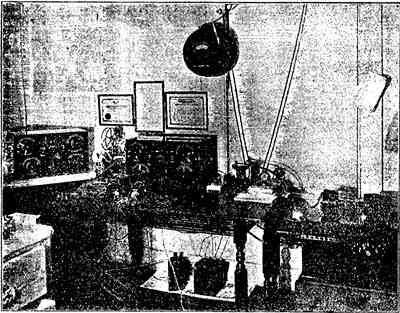
R. S. Miner.
The following list of amateur stations have been copied this fall, prior to December 15th, at 1VN. Hartford, Connecticut:
| Call Letters | Location | Operator | Power | Distance | |||
| * | 1IZ | ¾ | Kw. | 60 | Miles | ||
| * | 1ZR | 1 | Kw. | 200 | "" | ||
| * | 1ZW | ½ | Kw. | 75 | "" | ||
| 2AGI | 90 | "" | |||||
| 2BO | ¼ | Kw. | 120 | "" | |||
| * | 2DA | ½ | Kw. | 65 | "" | ||
| 2DN | ¾ | Kw. | 180 | "" | |||
| 2IB | ¾ | Kw. | 110 | "" | |||
| 2JD | 1 | Kw. | 110 | "" | |||
| * | 2KK | ¾ | Kw. | 150 | "" | ||
| * | 2SX | 1 | Kw. | 95 | "" | ||
| * | 2ZP | ½ | Kw. | 80 | "" | ||
| * | 3NB | ¾ | Kw. | 250 | "" | ||
| 3SS | 1 | Kw. | 200 | "" | |||
| * | 3ZS | 1 | Kw. | 200 | "" | ||
| * | 8ADB | ½ | Kw. | 450 | "" | ||
| 8AEZ | 460 | "" | |||||
| 8ER | ½ | Kw. | 550 | "" | |||
| 8IF | ½ | Kw. | 350 | "" | |||
| * | 8YC | 1 | Kw. | 400 | "" | ||
| 8YL | 1 | Kw. | 460 | "" | |||
| 8ZM | 1 | Kw. | 600 | "" | |||
| * | 8ZW | 1 | Kw. | 450 | "" | ||
NOTES.
* An American Radio Relay League Station.
Power in Kilowatts and Distance in Miles is only approximate.
Many other stations have been heard at 1VN, but the space in "QST" is becoming so valuable that they could not be given in tabulated form. Here is a list of a few more calls. 2MA, 2PH, 2PV, 2SZ, 3UF, 3VX, 3WN, 8ALE, 8BD, 8CO, 8GT, 8LD, 8LG, 8PC, 8RD, 8VI, 8YO, 8ZK, 9WO.
No doubt some of you will be surprised to see your call in this list. How many of you keep a record of the stations you hear. If you do not, try it. Look up each call and some times stop and wonder how an amateur with one Kw. or less, covers such remarkable distances.
I have been asked to give some of the characteristics of these successful stations. First of all, let us consider the pitch or tone. Of all the stations I hear, 75% have a high pitch, and you may be sure they are much easier to read. 8IF, Buffalo, N. Y., has about 120 cycle tone, and although he is loud it has been hard to copy him through the QRN; while 8ZW way down in West Virginia, can be copied with ease on account of his five hundred cycle pitch. 3ZS and 1ZR come in fine with their high tones. Occasionally we notice a station fade away when his rotary reaches high speed.
This is generally caused by using too much condenser for the high spark frequency. Sending condensers should be variable, in small steps and a great deal of care should be used in tuning your station to make sure that the right capacity is used. The smaller the capacity of your condenser, the higher your spark frequency may be and the more turns of inductance may be used in the primary of the oscillation transformer to maintain a certain wave length. This alone is of great advantage as it allows the use of closer coupling. Thus the radiation of the secondary or open circuit is increased while still maintaining a sharp wave.
I believe that most of our transmitting sets are efficient, but I have my doubts about a great many receiving sets. The audion is the only detector capable of this long distance work. I do not use an audion for I find they cause too much QRM. If you can not read a station through QRM with a good audion bulb, you will never read him with all the amplifiers in existence. I find to get the best results, the audion must be constantly adjusted. The high tension batteries must be variable, one cell at a time, and the constant variation of these batteries cutting in or out a cell or two will often allow a high pitch station to be read through a low pitch or vice versa. It is not advisable to burn the filament bright enough to make the bulb hiss. Then too, you must not adjust your audion to maximum loudness of signals from a very strong station and think it is adjusted for best results from a weak station; for often this is not the case. A series condenser in the antenna lead is almost a necessity, as it permits the use of more inductance on the primary of the loose coupler and a corresponding amount of closer tuning. The insulation is also very important, not only on high voltage transmitters but on the receiving sets. Summing it all up, we might say that although the amateur is limited to one Kw., his output is only limited to his patience, ability and the quality of his instruments.
When you receive a distant station, drop the owner a postal and tell him so. It won't cost you much and it will encourage the other fellow to work harder, and will go a long way towards stimulating the interest in the most wonderful of all pastime.

"American Radio Relay Station, 1VN"